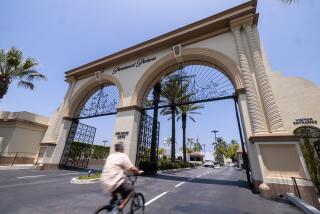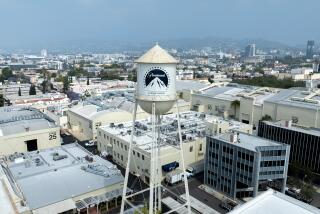Leonard Goldenson, ABC Network Pioneer, Dies at 94
- Share via
Leonard H. Goldenson, the last surviving patriarch of American broadcasting, who established ABC as a legitimate third television network and revolutionized his industry by convincing movie studios to produce television programs, died Monday. He was 94.
The media pioneer died at his home near Sarasota, Fla., where he lived in retirement, the network said.
Goldenson, CBS’ William S. Paley and NBC’s David Sarnoff launched the three entities that have served as the focal point of television for the last 50 years.
In a visionary leap born in part of necessity, Goldenson persuaded movie studios to begin filming programs for television, creating an enterprise worth billions of dollars. He achieved this at a time when Hollywood moguls viewed the new medium of television as the enemy and saw Goldenson--previously one of them as an executive at Paramount--as a turncoat for getting into it.
ABC proved to be a training ground for some of the entertainment industry’s leading figures. The roster of ABC alumni Goldenson helped mentor includes Michael Eisner, chairman of Walt Disney Co., which now owns ABC; Marcy Carsey and Tom Werner, producers of “Roseanne” and “The Cosby Show”; and Barry Diller, chairman of USA Networks Inc.
Diller, who is credited with establishing the viability of the made-for-television movie during his tenure at ABC in the 1970s and subsequently oversaw the launch of the Fox network, said Goldenson’s generosity with those who worked for him was his greatest strength and what set him apart from the other media giants of his era.
“He gave people authority and responsibility who didn’t qualify 1/8for it 3/8, except that his instincts told him that he should,” Diller said. “He was such a completely unpretentious man, he was so generously un-egotistical, his legacy--as opposed to Paley or Sarnoff--was really undervalued.”
In 1951, Goldenson, then president of United Paramount Theatres, prevailed upon his board of directors to pay $25 million for the American Broadcasting Co., which he acquired from Edward Noble.
American Broadcasting had come into existence in the 1920s as NBC’s Blue Radio Network, which Sarnoff used as a testing ground while A-level programming went to NBC’s Red Network. In the 1940s, the Federal Communications Commission ruled that no one company could operate two networks, forcing the sale to Noble, who had made a fortune on the Life Savers candy company.
Less than a decade later, Noble was losing money and eager to sell the operation. ABC had only 14 affiliated stations and reached about 33% of the nation’s households, compared with about 85% for CBS and NBC. Still, Goldenson met his asking price, even though the enterprise was estimated to be worth less than half that much.
Ambitions Tied to Television
“I was hell-bent to get into television,” Goldenson said in his 1991 autobiography, “Beating the Odds,” adding that he saw the medium as an “irresistible tide.” Citing antitrust concerns, the FCC took 18 months to approve the merger, and ABC officially embarked on its goal of becoming a legitimate third network under Goldenson in February 1953.
Paley and Sarnoff dismissed ABC as little threat to their broadcasting empires; in fact, the latter famously told Goldenson he should turn ABC into a “second-run network,” repeating shows that had aired on CBS and NBC, which controlled the top stars who had made the shift from radio to television.
Sarnoff believed that television, like radio, was a live medium, while Goldenson--whose career had been in film--saw a connection between television and motion pictures. Unable to compete with CBS and NBC for big-name radio talent, Goldenson turned to Hollywood.
“They had the 1/8Jack 3/8 Bennys, the 1/8Bob 3/8 Hopes, the 1/8Arthur 3/8 Godfreys, the 1/8Milton 3/8 Berles. All ABC had was Ozzie and Harriet,” Goldenson recalled in a 1987 interview. “My position was we had to . . . bring Hollywood to television.”
The executive met with a chilly reception. Chiefs at the movie studios considered Goldenson a traitor for getting into the television business, which they feared would cannibalize their box office. Warner Bros. mandated that television was not to be seen or mentioned in its films and that no executive was to have a TV in his office.
Desperate for programming, Goldenson made a deal with Walt Disney--who had been rejected by both Sarnoff and Paley--to help secure financing for his planned amusement park, Disneyland. In exchange, Disney would produce a weekly series, “Disneyland,” which began airing in 1954, and open up his library of animated films to ABC, which also shrewdly took a stake in the park and its food concessions for a decade.
Still, Disney was not a major studio at that time. The breakthrough on that front came when Goldenson finally convinced Jack Warner, over a 4 1/2-hour dinner in the Sunset Strip restaurant LaRue, to produce original programming for the network, promising the mogul time within each show to promote Warner Bros. movies.
In 1955, ABC launched three series under the “Warner Bros. Presents” banner, one of which--the Western “Cheyenne,” starring Clint Walker--became a huge hit, prompting a flurry of TV Westerns as other studios jumped on the bandwagon. Before the decade was over, four out of five prime-time programs were being produced in Hollywood.
“I think he saved Hollywood,” said Marvin J. Wolf, who helped write “Beating the Odds.” “They all thought of television as a rival. Goldenson had the vision to see they could be partners.”
Knowing the Audience
ABC also struck upon a notion that became a central aspect of today’s television business: catering to youthful demographic groups, particularly families with young children, who were perceived as being less loyal to a particular sponsor and thus more malleable in their buying habits.
Less stodgy than its elder rivals, who relied on stars associated with radio, ABC, spurred by programming executive Ollie Treyz, introduced such shows as “Maverick,” “77 Sunset Strip” and “Ben Casey”--programs that introduced fresh new faces to the public.
Pursuing this strategy, Goldenson said, required different kinds of executives--”up-and-comers who hadn’t become satisfied with success and who were willing to experiment and take risks. People out to make names for themselves.” As a result, ABC became a breeding ground for top executives.
Eisner, who sought Goldenson’s counsel long after leaving ABC, said through a spokesman, “He showed me it was acceptable . . . to support the creative process, and to be age-indiscriminate both on the younger and older side of the human equation. He will always be remembered as one of the pioneers of modern broadcasting.”
ABC made gradual strides through the 1960s, overtaking CBS and NBC with a three-year reign as the top-rated network in the late 1970s, thanks in part to its blockbuster 1977 miniseries “Roots.” ABC’s success was based on the popularity of such programs as “Charlie’s Angels,” “Laverne & Shirley,” “Happy Days” and “Monday Night Football.”
As a sign of Goldenson’s lack of ego, Diller remembers, even at the network’s acme his boss continued to fly coach. Ratings slipped a bit in the early 1980s, but by then ABC had clearly achieved parity with its two rivals.
Having survived numerous takeover attempts, including one by Howard Hughes in the 1960s, and a failed merger with ITT, Goldenson recognized an inevitable shift toward consolidation of the television business. In 1985, after 32 years running ABC, he agreed to sell the network to Capital Cities for $3.5 billion, at that time the biggest non-oil merger in history.
Under Chief Executive Thomas Murphy, Capital Cities provided a decade of solid management that made ABC one of the most admired entertainment companies.
Goldenson “saw the writing on the wall, that you needed deeper pockets, and he found the right partner,” said New Yorker media critic Ken Auletta, who chronicled changes in network television in his book “Three Blind Mice.” Both NBC and CBS changed hands shortly after the ABC-Capital Cities merger.
Although he moved to Florida and relinquished his role running the company, Goldenson retained the title of chairman of the executive committee for a decade, continuing to screen each new series prototype ABC produced until its acquisition by Disney.
Born in Scottdale, Pa., in 1905, Goldenson grew up in one of only four Jewish families in the town. His mother was a Russian immigrant, and his father owned a clothing store as well as an interest in two small theaters, which helped spur Goldenson’s fascination with the movie business.
Goldenson attended Harvard as an undergraduate and for law school, and briefly worked in a law firm before joining Paramount Pictures in 1933. Eventually, he was put in charge of the studio’s 1,700 motion picture theaters, becoming president of United Paramount Theatres when Paramount and other Hollywood studios were forced by the Department of Justice to separate production and distribution activities.
Goldenson’s wide circle of friends included President Lyndon B. Johnson, who had owned a television station in Austin, Tex., that carried ABC’s college football programming. In his autobiography, the executive recalled skinny-dipping with Johnson in the White House pool after the president suggested a swim before lunch.
“He was very thin-skinned, and sometimes he objected to the way he was treated in the news,” Goldenson said.
Beyond the entertainment industry, Goldenson will be remembered for his philanthropic endeavors, most notably in regard to cerebral palsy. His first daughter, Genise, known to the family as Cookie, was born with the disease, and Goldenson leveraged his media contacts to establish United Cerebral Palsy, which grew to become one of the nation’s largest charitable health organizations.
Goldenson served as the charity’s president for five years. He and his wife were also instrumental in championing access for the handicapped to public venues through the Americans With Disabilities Act. Cookie Goldenson died in 1973, at the age of 29.
In recent years, Goldenson made major donations to various organizations, including $60 million--bout half his fortune--to the Harvard Medical School, which dedicated the Leonard Goldenson Biomedical Research Building in 1994. The Academy of Television Arts & Sciences theater in North Hollywood also bears his name.
Goldenson is survived by his wife, Isabelle, daughters Maxine Goldenson and Loreen Arbus, both of whom have worked in television as producers, and one grandchild.
His funeral will be private. The ABC network said a memorial service will be planned in New York in January.
More to Read
The biggest entertainment stories
Get our big stories about Hollywood, film, television, music, arts, culture and more right in your inbox as soon as they publish.
You may occasionally receive promotional content from the Los Angeles Times.










